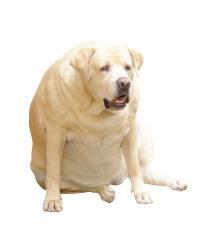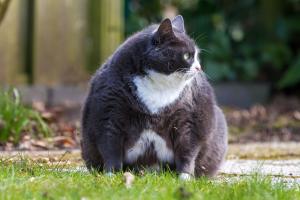Love, not LBs. The Pet Obesity Crisis
Pets packing on the pounds? We don’t go long these days without hearing something about the battle of the bulge, eating properly, and getting enough exercise. If we’re overweight, our health is at risk. But, did you know the same holds true for our pets? While we like to cuddle with our pets, unlike fluffy plush toys our dogs and cats should not be pudgy around the middle.
Seventy-five to 80 percent of the pets we see at Progressive Animal Wellness are overweight. They can develop many health problems including osteoarthritis, diabetes, high blood pressure, breathing problems, kidney disease, cancers, and shortened life expectancy. In cats, specifically, obesity is the leading cause of feline diabetes: expensive and difficult to treat, but easy and affordable to prevent.
Is My Pet Overweight?
Many people don’t realize their pets are overweight. How can you tell? Ideal weight is not a number, so rather than look at their weight on a scale we need to look at their bodies. Looking at a dog from behind, the chest should be wider than the waist. From the side, a dog’s chest should come down lower than its waist. You want to be able to feel a dog’s ribs, but not see them. Cats, on the other hand, don’t have a natural slim waist because they hold all their weight in their waist, so it’s important to look at the overall size of the cat.
Diagnosis
If your veterinarian determines your pet is overweight, even obese, he can use the animal’s weight in a special formula to calculate how much and what kind of food should be given to optimize weight loss. Cats can safely lose about eight pounds in a year.
Many people like to cook for their pets, however many at home diets are not nutritionally complete. Fortunately, in this area we have great holistic pet food stores such as Dogology and Green Dog Market where you can get human grade treats and diets, as well as excellent nutritional advice. And an occasional home-cooked meal won’t do any harm, just keep a close eye on fat content to avoid a pancreatitis attack, and stay away from feeding table scraps.
Food Is Not Love
We feed our pets to show them we love them. It can probably be said that no matter how much we feed them, we love them far more. So, how can we show them affection without overfeeding them? First and foremost, give them praise, both verbally and physically. If you want to reward them with food, try veggies such as carrots and green beans. And, of course, there are packaged treats that are low in calories and taste great; however, remember that one treat is just as good as 10 to a pet as long as they get the treat.
Get Moving
Our pets need exercise just like we do. Dogs love to go for walks, even jogs, as well as play fetch and go swimming (some breeds). In fact, with summer break around the corner for the kids, a great way to keep them moving as well is to have them take the dog for a walk. In addition, walking your dog has a much stronger bonding effect than giving food!
Cats tend to be more sedentary, but there are still plenty of things we can do to get them moving. First, if you live in a home with more than one floor, put the cat’s food and water dishes on a different level of the house than his litter box. If you’re on one floor, just place the food and water as far away from the litter box as possible. Also, cats love laser pointers. Zip that little red light all over the room and watch your cat have a blast trying to catch it.
The good news for overweight pets is they can shed weight very quickly. The weight loss will be faster in the beginning and level off as the goal becomes closer. The best remedy is to feed them less, in accordance with a plan developed by your vet; get them moving more; and be sure to visit your vet for a wellness checkup at least once per year.

